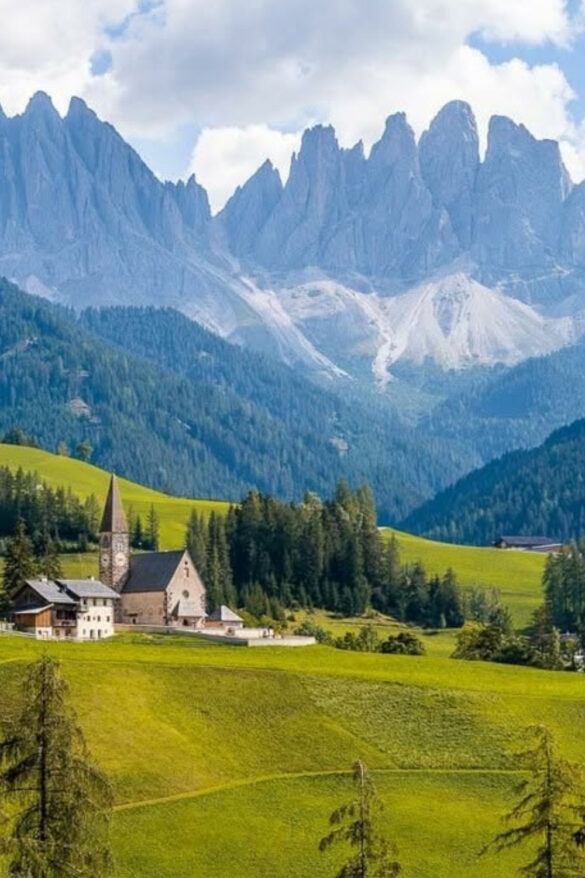The Allure of American Culinary Hotspots: Why Foodies Flock to These Cities
The cuisine in America is a colorful mosaic that is constantly changing and amazingly diverse. To the discriminating foodie, some cities are shining lights of culinary novelty, culture, and unadulterated yummy. However, what about these places makes them become actual foodie paradises? It is not simply a bunch of restaurants that are good, but it is a combination of factors that make the dining experience unique.
First of all, there is culinary diversity. As a melting pot of cultures, the United States of course has a fantastic selection of ethnic cuisine as well as classic American cuisine. Authentic regional Italian to spicy Szechuan, innovative Modern American to soulful Southern comfort food, these food hubs provide an international cuisine tour on one plate. Diversity like this is not merely the presence of a number of options but a bounty and the genuineness of every category, and every category is reproduced on a regular basis by immigrant communities that carry their food cultures to new places.
Second, it is essential to have a successful restaurant industry. This encompasses not only the fine, Michelin starred restaurants but also the vibe of food truck cultures, busy farmers markets, new pop-ups, and neighborhood favorite restaurants. A healthy restaurant ecosystem is competitive, creative, and accessible where all palates and budgets are considered. The dynamism of this environment typically leads to the birth and growth of culinary tendencies, so that the dining scene never stops being new and exciting.
Take into account the economic value of a good restaurant scene. The National Restaurant Association reports that the restaurant business can be called the pillar of the U.S. economy, and its sales are estimated to reach $997 billion in 2023. Larger shares of such economic activity often occur in cities that have bustling food scenes which help stimulate local employment and tourism.

Key Characteristics of a Culinary Hotspot
| Characteristic | Description |
| Diverse Cuisines | Wide range of authentic ethnic and regional American dishes. |
| Innovative Chefs | Chefs pushing boundaries, experimenting with flavors and techniques. |
| Local Sourcing | Emphasis on fresh, seasonal ingredients from nearby farms and producers. |
| Vibrant Food Culture | Strong community engagement with food, including markets, festivals, and culinary events. |
| Accessibility | Options for various budgets, from fine dining to casual street food. |
| Historical Significance | Cities with a rich culinary past often boast deeply rooted food traditions. |
| Culinary Education & Talent | Presence of culinary schools and a pool of skilled chefs and restaurateurs. |
Thirdly, innovation and food talent are important drivers. Those cities bring in bold chefs willing to experiment, explore further, and innovate in their food. They usually have the advantage of a circle of fellow professionals, suppliers, and enthusiastic diners open to trying something new. This is a virtue of innovation that extends beyond the realm of fine dining, and to every rung within the food ladder, such as inventive food trucks, all the way to the artisans of the bakery.
Last but not least, sourcing and the quality of ingredients are local. The greatest culinary cities tend to be closely linked to agricultural areas, giving the chefs access to local, high quality, and seasonal food. The phenomenon of farm-to-table is not a fad, but rather a philosophy, putting freshness, sustainability, and the economic development of the local population in the center of the discussion, which directly affects the taste and quality of food offered. The relationship between the plate and the land is what in fact makes a dining experience transcendent, writes Chef Alice Waters, one of the pioneers of the farm-to-table movement.
Simply put, when all of these elements come together, a city turns into a paradise of foodies, where food ceases to be a means of survival but a form of art, a cultural expression, and a source of great happiness. This is a roadmap that will help you to navigate this dramatic terrain and discover your own Foodie’s Paradise: Your Guide to the Best Culinary Cities in America.
New York City: The Global Culinary Capital
New York City’s culinary landscape is a dynamic reflection of its immense cultural diversity. More than a city of restaurants, it’s a world of flavors contained within five boroughs. While the sheer number of dining options can be overwhelming—with over 25,000 establishments—it’s this abundance that makes NYC a true foodie mecca. The city’s food scene is defined by its ability to offer everything from world-class, multi-course tasting menus to a humble, yet perfect, dollar slice of pizza.
A visit to NYC is a journey through different culinary worlds. In Manhattan, you can find Michelin-starred restaurants like Le Bernardin, celebrated for its exquisite seafood, or travel to the historic neighborhoods. Little Italy still holds onto its red-sauce roots, while the Lower East Side is steeped in Jewish deli tradition, famous for its towering pastrami sandwiches. The city’s immigrant communities have shaped its cuisine for centuries. For example, Flushing, Queens, is home to a vast array of authentic Chinese regional cuisines, while Jackson Heights offers a rich tapestry of South Asian, Latin American, and Tibetan flavors. This diversity is what makes the city’s food scene so vibrant and constantly evolving.
Beyond the brick-and-mortar restaurants, New York’s street food culture is an integral part of its identity. The city is famous for its food carts, offering everything from classic hot dogs and pretzels to the iconic Halal Guys’ chicken and rice. These mobile kitchens provide a delicious and affordable way to experience the city’s flavors on the go. The rise of pop-up dining and food halls like Chelsea Market has also created new platforms for chefs and artisans to showcase their creations, often focusing on hyper-local and seasonal ingredients.

Chicago: Deep-Dish and Beyond
Although Chicago is widely known as the place where you can get deep-dish pizza, the food culture of this city has so much more to offer. The food culture in the Windy City can be defined as having a sense of identity, a blend of fine gastronomy, and heavy-handed, working-class comfort food. Chicago has long been considered one of the best foodie cities and deservedly so. It has several Michelin-starred restaurants, and chefs such as Grant Achatz are taking modern cuisine to the limit.
The ethnic and working-class history of the city is entrenched in the food. Some of the most iconic dishes that represent Chicago include its birthplace:
– The Italian beef sandwich: A sloppy, tasty jumble of thinly-sliced roast beef piled high on a long roll and dipped in its own juices.
- The Chicago-style hot dog: A frankfurter covered with a certain mixture of yellow mustard, sliced white onions, bright green sweet pickle relish, A dill pickle spear, tomato slices, pickled sport peppers and a sprinkling of celery salt on a poppy seed bun. Note deliberate omission of ketchup.
- Saganaki flaming: This dish of Greek cheese was made famous in the Grektown in Chicago and usually comes flamed with a scream of Opa!
- The Jibarito: This sandwich was created in a Puerto Rican area of Chicago; it replaces bread with flattened and fried plantains.
The neighborhoods of the city all play a part in the culinary scene. Starting with the Mexican cuisine in Pilsen that is too good to be found anywhere in the world and ending with the Polish cuisine in Avondale, the best way to explore the Chicago food scene is to do it by neighborhood. The result of this decentralization is that any section of the city may be an under-the-radar foodie discovery and may be both a very sophisticated place and one that is deeply connected to the culture of a specific region.
Los Angeles: A Fusion of Global Flavors
Los Angeles is a food capital that prides itself on being very diverse and innovative. Another sign that the city is a global hub is its food scene, which features significant representation of Mexican, Thai, Korean, and Japanese food. LA is a diverse food frontier that consists of a mix of up-market restaurants, casual restaurants, food trucks, and street vendors offering an authentic representation of the diverse culture of the city.
Los Angeles is a taco heaven, there is no use denying the effect of its neighboring Mexico. You will get classic and simple street tacos and fancy ones designed by renowned chefs. The Koreatown of the city is the largest population of Koreans outside of Korea and its food industry is worth visiting by those who adore their Korean BBQ, stews, and apparently unlimited variety of authentic cuisine. The city also boasts the biggest Thai population in the world beyond Thailand and its colorful Thai Town serves some of the more authentic cuisine in the land.
LA also leads in gastronomic trends and is highly concentrated on healthy and vegetarian cuisine. Its proximity to fresh produce throughout the year provided by local farmers markets has placed it on the forefront of the farm to table movement. This focus on new quality ingredients is visible at the most basic of dining establishments, as well as in the most high-end restaurants with multiple Michelin stars. The fact that the city can perfectly blend various cultures and cuisine styles is what makes it one of the most thrilling and vibrant food cities in the world.
San Francisco: The Epicenter of Farm-to-Table
The culinary identity of San Francisco is based on the areas surrounding it including fertile farmlands, the Pacific Ocean, and the spirit of innovation found in the Bay Area. It is generally regarded as one of the top foodie destinations in the city, due to its adherence to local sourcing and a deeply upheld philosophy of farm-to-table. Food is an advanced blend of the old culture and the new-wave culture and a food lover must not miss the city.
Sourdough bread is considered one of the most iconic foods in San Francisco. The microclimate of the city provides just the right environment to the wild yeast which brings the bread its tangy flavor. One of the classic experiences in San Francisco is eating a clam chowder in a Sourdough bread bowl. The city sea food has not been left behind either, the shellfish is also popular and one of the local delicacies is the Dungeness crab. The Mission District of the city of San Francisco is where the popular Mission Burrito was born as a larger, better-filled variant of the traditional burrito that has gained national popularity.
The eclectic diversity of the city has provided it with an array of authentic choices in its culinary landscape. One of the oldest Chinatowns in North America has unbelievable dim sum, and the North Beach neighborhood, the Little Italy in this city, is not deprived of classic Italian gastronomes. San Francisco is a pioneer city of American craft beer and coffee movements as well, and there are numerous new breweries and artisanal roasters. The food culture in the city is not only about the restaurant experience, but about the appreciation of ingredients used in the food, the craftsmanship of the chefs, and the history of the food.
Seattle Seafood and Coffee Culture.
The Seattle food and beverage industry is an ideal combination of its coastal setting and its progressive and community-based attitude. Although it is known around the world due to its coffee culture and the legendary Pike Place Market, Seattle is a food wonderland in its own right, hosting an impressive array of fresh, local, and innovative cuisine. The city has access to the Pacific Ocean, and this fact makes fresh seafood one of the foundations of its cuisine.
Seattle has outstanding seafood, and its specialty is fresh salmon, oysters and Dungeness crab. The restaurants of the city, big and small, oyster-bars and fine restaurants alike, have been a demonstration of the harvest-abundance of the sea, with a certain deference to simple and pure tastes. In addition to seafood, the rich population of Seattle has developed a very successful international cuisine. Authentic Asian dishes, especially Vietnamese and Thai, are also abundant in the city and are known to be of high quality and authenticity. Each of the neighborhoods in the city has its own culinary vision.
The Seattle food scene can be characterized by the following features:
- Pike Place Market: A legendary open-air shopping center full of sound, smell, and taste of fresh goods, seafood, and crafted goods. It is the place of the first shop Starbucks and thousands of other little food sellers.
- Coffee Culture: The impact of Seattle on the American coffee culture cannot be compared. There is a large number of independent roasters and cafes in the city that focus on quality, including the sourcing of beans and the way they are brewed.
- Farm-to-Table: The chefs of Seattle are as committed as those of the West Coast to finding ingredients as local as possible, frequently in the fertile farmland and waterways of the Pacific North West.
- Creative Cocktails: The drinks market in the city does not limit itself to coffee as more and more distilleries and cocktail bars are opening up and challenging their limits.
The food scene of Seattle speaks to the natural resources that this city is endowed with and to the community of enthusiastic chefs, providing a wholesome and intellectually stimulating experience. It is a locality where every food-stuff, whether it is a well-bred oyster or a cup of coffee, has a story to tell you how it was made.
Portland, Oregon: The Food Cart Phenomenon
Portland, Oregon, has carved out a unique and celebrated niche in the American culinary landscape. Often called a “foodie paradise,” its reputation is built on an accessible, creative, and unpretentious food scene that has gained national acclaim. The city is a haven for independent chefs, brewers, and artisans who are committed to quality and innovation without the high-end price tag of larger metropolitan areas.
The cornerstone of Portland’s food scene is its legendary food cart pods. These are collections of dozens, or even hundreds, of individual food carts clustered together in parking lots, offering an incredible variety of global and local cuisines. From authentic Thai to innovative Ethiopian, and from Korean BBQ to artisanal donuts, the food cart scene provides a low-cost, high-creativity platform for chefs. This has allowed Portland to develop a rich and diverse culinary culture that is both affordable and incredibly delicious.
Beyond the food carts, Portland is a leader in several food and beverage trends.
- Craft Beer: The city is often referred to as “Beervana” for its staggering number of microbreweries and brewpubs.
- Donuts: The city’s donut scene, led by iconic shops like Voodoo Doughnut, is a major draw for visitors.
- Coffee: Similar to Seattle, Portland has a thriving third-wave coffee scene with a focus on high-quality, ethically sourced beans.
Portland’s emphasis on sustainability and local sourcing is also a key part of its identity. Its proximity to farms and ranches in the Willamette Valley means a consistent supply of fresh, seasonal ingredients for its restaurants. This commitment to local, independent producers creates a tight-knit culinary community that is both supportive and fiercely creative.

References:
- National Restaurant Association. (2023). Restaurant Industry Facts at a Glance.
- Bon Appetit. (2022). The Best Restaurant Cities in America.
- Michelin Guide. (2023). New York, Chicago, San Francisco Guides.
- Oregon Tourism Commission. (2023). A Food Lover’s Guide to Portland.





